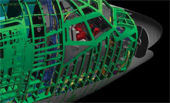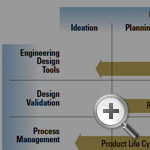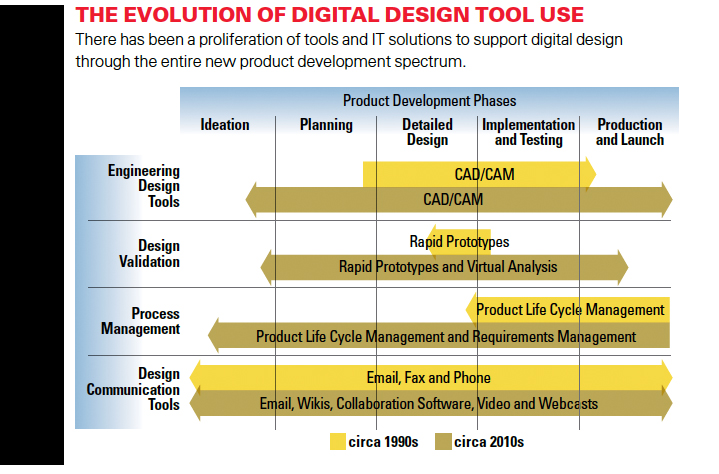The Problem With Digital Design
Yes, digital design is a wonderful tool. But unless it is supported with strong management processes, there can be unintended — and negative — consequences.

Today’s product development is nearly all digital — allowing teams to go from idea to precise parts quickly, and permitting them to continually revise and validate throughout the development process.
Image courtesy of Boeing.
The widespread adoption of digital design shows that it makes a powerful contribution to R&D effectiveness and efficiency. Design tools can be invaluable in visualizing ideas, quickly developing a detailed design and conducting fast iterations. On the surface, these are all good things. Yet our research suggests that digital design is not a panacea. Unless it is complemented with sound management practices, unforeseen problems will be introduced into the product development process.
Some background will help explain why. It is well known that since the 1980s, the new product development process has evolved from traditional engineering teams working together in one place to an approach that is more global and virtual.1 One major factor that has enabled this transition has been the proliferation of digital design tools such as highly capable computer aided design packages (such as Parametric Technology Corp.’s PTC Creo Elements/Pro (formerly Pro/ENGINEER), Dassault Systèmes’ CATIA and SolidWorks), rapid prototyping technologies (such as 3D printers), and collaboration tools (such as Microsoft SharePoint, Google Docs and project wikis).
The Leading Question
What potential downsides does digital design introduce into product development?
Findings
- Digital design tools can make the work appear complete before it actually is, creating problems down the line.
- Because the tools are simple to use, they can promote endless tinkering, delaying production.
- Strong managers — and well-defined management processes — are needed to guard against both potential problems.
A second factor leading to increased use? Lower prices. Today, capable CAD packages can cost as little as a few hundred dollars and can run efficiently on desktop or laptop computers costing a fraction of those required just five years ago.
One of the most widely studied payoffs of digital design was the Boeing 777, which was designed, modeled and tested virtually by an extended development team.2 The benefits of this approach included identifying part interference and fit issues before expensive physical prototyping and having different members of the organization (customers, manufacturing representatives, vendors, service and maintenance individuals, etc.) view and participate simultaneously in the design process.
Since the time of the 777, the use of information technologies and services has accelerated thanks to the proliferation of tools and IT solutions to support digital design through the entire new product development spectrum. Systems for 3D printing (from companies such as Z Corp.) allow designers to quickly produce prototype parts directly from CAD files, permitting the physical validation of engineered designs in a matter of hours. Power analysis tools, often integrated into CAD systems, allow virtual testing before any physical prototypes and preliminary manufactured parts are produced. From airflow within a jet engine (fluid dynamics simulation) to strength and fatigue testing on a vehicle chassis (finite element analysis), these tools offer the potential to reduce cost and improve design iteration efficiency.3 And process management tools, such as product life cycle management and requirements management, have proliferated to dimensionalize costs, part reuse and customer needs. Moreover, engineers can vet concepts with colleagues around the globe through virtual collaboration technologies that are now commonplace and, increasingly, free. In sum, today’s product development is nearly all digital — allowing teams to go from idea to precise parts quickly and permitting them to continually revise and validate throughout the development process. (See “The Evolution of Digital Design Tool Use.”)
So, what’s the problem? There are potentially two. First, because the technology makes the work look complete at every step in the process, it can create a false sense of security. There can be a tendency to move on to the next stage in the process before teams have taken the time to deeply learn user needs, construct alternative solutions and vet both of these. In other words, the “fuzzy front end” of the design process may be cut short — to the company’s long-term disadvantage. This is, we believe, one of the major reasons product failure and success rates have changed little over the past several decades.4
Second, the very ease with which designs can be digitally drafted and prototyped might afford engineers the opportunity to “try it again and then, again and again.” In other words, the final design process can remain fluid longer than is useful. The ability to quickly iterate designs can lead to a spiraling effect, chewing up time and labor expense and effectively mitigating the benefits of digital
design itself. Research has shown that these “virtual design rounds” can account for 75% of total project development costs,5 and they can delay project completion. For example, Airbus suffered severe delays in the development of its new A380 due to issues with CAD revisions.6
The net takeaway from this: While we are favorably inclined to the generally positive impact of digital design — who today would argue against the use of computers for any aspect of commerce? — we wanted to more deeply understand these two possible unwanted effects and how to best mitigate them. To accomplish this, we embarked on a longitudinal study of the product development activities of 145 firms that are heavy users of digital design technology. Given that a majority of engineering time is spent in front of a computer revising CAD models, we focused our lens on the engineering bullpen. We surveyed and interviewed engineers and managers to understand how digital design work is performed. (See “About the Research.”) Here’s what we learned.
A Rush to “Final” Design
Modern digital tools allow fast iterations of design features and dimensions, once the engineer constructs a virtual model. This ability creates a strong pull for product development teams to jump to building digital design models right at the start of the project. Because digital design applications are inherently precise, the “fuzziness” of wide-open concept exploration can be avoided for what seems to be a highly evolved design that is then prematurely moved downstream. That, we found, can lead the R&D team to shortchange valuable activities such as extensive user research, intensive parallel concept development, and deeper systems and architecture design as part of the front end of development.
Thomas Allen found decades ago that teams pursuing a number of parallel concept developments at the front end of design most often proved to be the winners over similar projects where teams finalized a design early in the process.7 This supports the common sense understanding that rushed decisions are often not the best. In the case of engineering design, a rushed decision can ultimately lead to more work downstream in the process as other engineers are forced to improve things. We call this effect back-loading, where digital design tools are used to revise and rework design problems that should have been resolved early in the process.
The obvious point is that a fast rendering is not a complete product design. Digital design allows engineers to produce realistic-looking concepts and prototypes quickly and much earlier in the process than ever before. While these designs look finalized, they are not. A beautifully sculpted and realistic exterior shell may not contain the inner structure and supports essential to a finished product. As one engineer at an aerospace firm explained, “Management looks at the early designs and thinks it’s done. However, there is a lot more engineering to be done on these early models.”
What is clear from all of this is that interactive product development should be front-loaded in the development cycle.8 Certainly, front-loading has been standard operating procedure in R&D. Concept developers (engineers) would complete and test new designs, then send them to manufacturing engineers for completion and potentially for modifications through tightly controlled drawings and a well-defined change management system. Not only has digital design allowed concept engineers a false sense of completeness, but it has also enabled later-stage engineers to more easily tinker with designs to try to make things better. And that brings us to problem number two.
Enough Is Enough
Digital design has made projects fluid across the entire development process, which ideally is a positive. However, on-the-ground reality sheds a different light on the situation. In an ideal environment, this flexibility might lead to a higher rate of problem solving and therefore, better products. In reality, however, many of the managers in our study complained about, in effect, too many cooks spoiling the broth. As one executive told us, “CAD has been democratized. It’s now a lot easier to use and share. The downside is: Everyone thinks they’re an engineer.”
In a poorly monitored process, the number of engineering changes to a specific design can increase dramatically. In fact, minor changes in one aspect of design can have strong ripple effects on other areas, potentially leading to an overall poorer final solution. Without a well-structured engineering process, the number of unnecessary iterations can mushroom simply because the technology makes changes so easy to perform. Chaos can ensue.
The data gathered from the companies in our study confirmed this problem. A large number of engineering changes late in the process were associated with the poorest-performing R&D organizations. Moreover, the poorest-performing organizations were heavy digital design users, underscoring the second potential problem. Since it is so easy to make changes, people continue to do so late in the process. (Of course, it is possible that the changes were necessary because the company moved too quickly on the front end.)
On the other hand, the most successful companies were practitioners of systematic planning in the upfront phases of product development and allocated considerable amounts of time and resources to these early stages. For example, the highest performing companies in our sample were 18% more likely to adopt systematic product road mapping and planning procedures than the rest. These companies also made cost engineering for new product designs a clear requirement during concept development.
The best-performing companies in our study were also 17% more likely to employ cost engineering during the front end of development. Managers would be well served to focus on defined planning and specifications, development of robust product architecture, well-defined interfaces and shared subsystems. Companies that operate in this fashion, such as Honda Motor Co., have a strong record of maximizing R&D investment over multiple, highly profitable product lines.9
Better upfront planning can reduce later iterations because fewer are necessary. And simple, better process adherence reduces later iterations by enforcing discipline. The lesson is clear: Use digital design tools and systems but not without a disciplined, well-controlled R&D process. Otherwise, product designs will continue to shift until near the moment of manufacture, causing undue waste and churn.
A Structured, Well-Managed Process Is Important
Confirming the existing new product development literature that endorses structured processes, we also found significant correlation between efficient use of R&D resources and well-defined conceptual and systems design phases.10 The most successful companies in our study were heavy users of digital design that combined these tools with management-driven process discipline. Specifically, they maintained a structured R&D approach that protected and preserved a front-loaded process that had sufficient time for deep user research (ethnography, focus groups, etc.), competitor analysis, and rough prototyping and systems architecture. As a manager of one of these well-managed companies told us: “We don’t see a ton of back-loading here because we are so focused on process. We’re very rigorous upfront, especially during planning.” Not surprisingly, the need for strong project management and communication was pervasive throughout our study. Often, a good project manager was seen as the key figure to stop back-loading from occurring. As one engineering vice president at a technology company explained: “We don’t see endless iterations in design. This is up to the project manager. We go through the necessary iterations and do not overdo it.”
A key contributor to project management and team effectiveness on the management of digital design was collaboration software such as wikis and Google Docs. We found that the best-performing firms were 26% more likely to adopt and use collaborative IT tools during design. In sum, powerful digital design systems need to be matched with appropriate process discipline, supported by a relevant IT infrastructure and collaboration tools.
We also observed that companies with incompatible CAD systems within development groups, or between themselves and suppliers, suffered significant disruptions and diseconomies in the development process. Companies that focused on implementing and maintaining a top-level IT infrastructure to bridge different R&D applications performed significantly better in terms of engineering efficiency.
It is imperative that internal departments, vendors and suppliers maintain consistent levels of software revision and training and that detail issues, such as
tolerances, for example, are clearly communicated. The most successful companies in our study reported a greater use of IT in facilitating training, compatibility and communication. The most successful companies in our study reported a 22% greater intensity in the use of IT to play a role in interdependencies among teams and organizations — facilitating training, compatibility and communication. In companies where such coordination doesn’t occur smoothly, problems can occur. As one engineer at a high-technology company explained: “It used to be that vendors — people making sheet metal parts or injection molded parts — would receive dimensioned, 2D drawings and check their parts versus samples, etc. Thought went into tolerances, fit, etc. Now, these vendors work right off the 3D solid models. The parts come back to us, and they don’t fit well.” That can cause unnecessary tooling and design revisions during production ramp-up. However, digital design allows for dimensions and drawing information to be included in the files. It is poor process discipline and equally poor management of the IT tools and their features, that is the root cause of the problem in this particular example. Ultimately, such problems have to be solved further down the line, causing unwanted back-loading.
Training and bullpen proficiency were shown to be important in our study. In the companies we studied, up to 75% of project time was directly related to digital design hours; without proper training in the digital design tool, that use of time is suboptimal. An engineering manager at a large aerospace company noted that designers were “the real experts,” and they needed to be trained accordingly. Training and proficiency are critical to R&D success. In our interviews, we found that younger engineers were often heavily reliant on digital design and were not fully vetted in engineering methodology. These less-seasoned engineers went right to solving the problem digitally, without fully defining and exploring the problem first — a significant contributor to back-loading.
The bottom line from our research? Innovation managers need to use caution in wholesale adoption of digital design technology. There is no doubt that having a computerized drafting board, backed by access to libraries of prior design widgets, product components and manufacturing costs, can save engineering design teams time and expense. Besides, new recruits live and breathe digital technology as college students, and there is no way that one can prevent their use of computers in the early design process.
That being said, while digital design certainly helps enhance R&D productivity, it also carries the risk of allowing designers and engineers to rush to conclusion prematurely, bypassing critical upfront steps that are so valuable to the project. The result is often a need to rework designs later in the process, reducing efficiency while increasing the risk of implementing “tweaks” that were not intended by upstream developers. In our research, the best-performing companies ensured that this does not happen through managerial oversight and protection of the front end of product development.
References
1. S.D. Eppinger and A.R. Chitkara, “The New Practice of Global Product Development,” MIT Sloan Management Review 47, no. 4 (summer 2006): 22-30.
2. K. Sabbagh, “Twenty-First Century Jet: The Making and Marketing of the Boeing 777” (New York: Scribner, 1996).
3. G. Chryssolouris, D. Mavrikios, N. Papakostas, D. Mourtzis, G. Michalos and K. Georgoulias, “Digital Manufacturing: History, Perspectives, and Outlook,” Proceedings of the Institution of Mechanical Engineers, Part B: Journal of Engineering Manufacture 223, no. 5 (May 2009): 451-462.
4. G. Barczak, A. Griffin and K.B. Kahn, “PERSPECTIVE: Trends and Drivers of Success in NPD Practices: Results of the 2003 PDMA Best Practices Study,” Journal of Product Innovation Management 26, no. 1 (January 2008): 3-23.
5. T.J. Marion and T.W. Simpson, “New Product Development Practice Application to an Early-Stage Firm: The Case of the PaperPro (R) StackMaster (TM),” Design Studies 30, no. 5 (September 2009): 561-587.
6. K. Wong, “What Grounded the Airbus A380?,” Cadalyst MCAD Tech News 194 (Dec. 7, 2006). www.cadalyst.com/manufacturing/news/mcad-tech-news-194-11900 (accessed January 13, 2011).
7. T.J. Allen, “Managing the Flow of Technology: Technology Transfer and the Dissemination of Technological Information Within the R&D Organization” (Cambridge, Massachusetts: MIT Press, 1984).
8. S.H. Thomke and T. Fujimoto, “The Effect of ‘Front-Loading’ Problem-Solving on Product Development Performance,” Journal of Product Innovation Management 17 no. 2 (2000): 128-142; see also S. Fixson and T.J. Marion (2012), “Back-loading: Unintended Consequences of Digital Design Tools in New Product Development,” Journal of Product Innovation Management, in press.
9. M.H. Meyer, “The Fast Path to Corporate Growth: Leveraging Knowledge and Technologies to New Market Applications” (New York: Oxford University Press, 2007).
10. R.G. Cooper, “Perspective: The Stage-Gate® Idea-to-Launch Process — Update, What’s New, and NexGen Systems,” Journal of Product Innovation Management 25, no. 3 (May 2008): 213-232; see also Barczak, Griffin and Kahn, “PERSPECTIVE,” Journal of Product Innovation Management 26:3-23.
i. R. Cooper and R.S. Kaplan, “The Design of Cost Management Systems” 2nd ed., (Upper Saddle River, New Jersey: Prentice Hall, 1999).
ii. J. Utterback, M. Meyer, T. Tuff and L. Richardson, “When Speeding Concepts to Market Can Be a Mistake,” Interfaces 22, no. 4 (July-August 1992): 24-37.


